Last updated on December 30th, 2023 at 02:52 pm
Wireless mixers are becoming more and more popular for the simple fact that you can set them up anywhere and forget about it.
No more cables running from one side of the venue to the other!
All you need is a tablet or iPad and you’re ready to go!
In this post I’ll do a deep-dive into the Behringer XR12-XR16 and the Soundcraft UI12-UI16 so you can better understand which one best suits your needs.
Note: None of these mixers are capable of multi-track recording, they are designed for live shows…
However, if you are looking for a wireless mixer that can do multi-track recording, then check this article I wrote about the Behringer XR18 and the Soundcraft UI24R.
Moving on…
Soundcraft UI12 and UI16
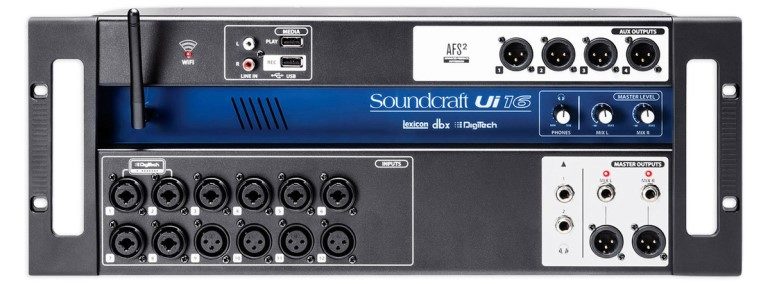
These are two almost identical wireless mixers with the only difference lying in the channel count they each provide, which are 12 and 16, respectively.
Let’s take a quick look at the inputs and outputs of each mixer;
Soundcraft UI12
Inputs: 4 x XLR/TRS combo jacks, 4 x XLR, and a stereo RCA…
Outputs: 2 x XLR and 2 x TRS connectors for the main outputs, and 2 extra XLR aux outputs, as well as 2 x ¼” headphone outputs.
Soundcraft UI16
Inputs: 8 x XLR/TRS Combo jacks, 4 x XLR, and a stereo RCA.
Outputs: 2 x XLR and 2 x TRS connectors for the main outputs, and 4 extra XLR aux outputs, as well as 2 x ¼” headphone outputs.
On both mixers, the first two inputs are also Hi-Z inputs which feature DigiTech’s amp modelling.
These inputs are designed to connect an electric guitar/bass directly to the mixer without the need of using a D.I. box.
This can definitely come in handy during live gigs where you don’t want to take guitar amps along, since these amp sims actually sound quite convincing.
None of these new wireless mixers feature any kind of channel strip, instead they are controlled wirelessly from an iPad, or any other device like an Android tablet, Mac, or PC.
The great thing about the Soundcraft wireless mixers is that you can connect to them through Wi-Fi and control their internal software via any HTML5-compatible browser…
And basically, every device out there can run such a browser (Chrome, FireFox, Safari, etc).
The software, which is used to control everything that’s going on inside the mixer, feels very similar to a regular DAW…
It’s super intuitive.
Here’s how it looks;
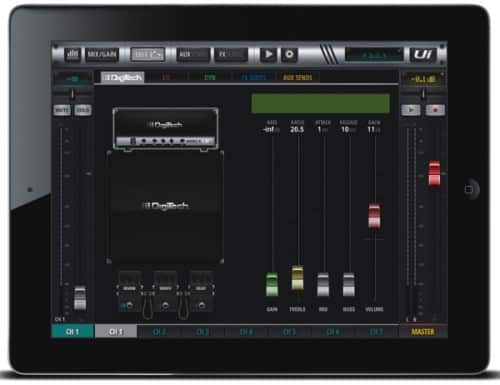
Note: It also has an Ethernet port, should you want to connect to the mixer via it.
Most wireless mixers require you to download an app, but with the Soundcraft mixers you just connect to the Wi-Fi they provide, and that’s it!
Not only that, but you can connect up to 10 different devices, which means that every band member can control their own effects, monitor mix, amp sim, etc.
There is even an HDMI output and an extra USB port, so that you can hook up a monitor and mouse, if you want to.
Moving on…
Onboard Effects
These mixers come with the Lexicon effects which include; reverbs, delay, and chorus.
Each channel also has Compression, de-essing, and noise-gating built in, plus a real time frequency analyzer.
Like I mentioned earlier, amp emulation for the first two inputs is also included, which provides a huge array of amps, cabinets, pedal effects, and more.
Feedback Fighting
The Soundcraft wireless mixers come with an advanced feedback suppression algorithm which listens to the incoming signal and can anticipate the problematic frequencies before the feedback begins.
This feedback suppression system won’t affect the sound of the performance one bit!
Recording capabilities
While it would be great to be able to do some multi-track recording with these mixers, it sadly can’t be done.
You can, however, record the entire session on-to a pen drive as a stereo file and then transfer this file to your PC/DAW.
And lastly…
These mixers will allow you to connect an external USB drive and playback music from it.
Features
- Can be controlled via any device that can open a browser
- Built-in effects and amp sims
- Integrated Wi-Fi connects up to 10 devices simultaneously
- 2-channel feedback suppressor
- Solid construction and design
Specifications
| Model | Soundcraft UI12 | Soundcraft UI16 |
| Channels | 12 | 16 |
| Inputs | 4 x XLR/TRS, 4 x XLR, 1 x RCA | 8 x XLR/TRS, 4 x XLR, 1x RCA |
| Outputs | 2 x XLR, 2 x TRS, 2 XLR AUX | 2 x XLR, 2 x TRS, 4 XLR AUX |
| MIDI I/O | No | No |
| Headphone Output | 2 x ¼” | 2 x ¼” |
| EQ Bands | 4-band Parametric | 4-band Parametric |
| Rackmountable | No | Yes |
| Multi-track Recording | No | No |
| USB Rec/Playback | Yes | Yes |
| App Required | No | No |
| Feedback Control | Yes | Yes |
Both Mixers are very affordable considering the number of inputs/outputs they provide, as well as the included effects, amp sims, and all other features.
They are definitely very cost-effective, which is always nice.
Find out more about the Soundcraft UI12 and the UI16 models here:
- Soundcraft UI12: Amazon, Sweetwater.
- Soundcraft UI16: Amazon, Sweetwater.
Behringer X-Air XR12 and XR16
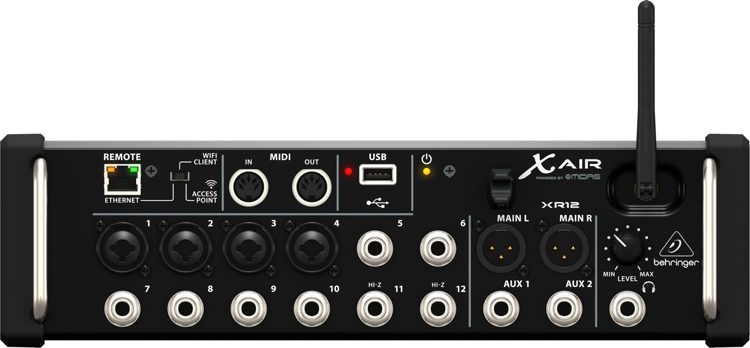
Just like with the Soundcraft mixers, the Behringer XR12 and XR16 are two almost identical mixers with the only difference being the overall channel count.
Let’s take a quick look at the inputs and outputs of each mixer;
Behringer XR12
Inputs: It features a total of 12 inputs, four of which are XLR/TRS combo jacks featuring their famous MIDAS preamps.
Of the other 8 TRS inputs, 6 are line level, which can be used to connect keyboards, etc.…
While the last two are Hi-Z inputs, which allow you to connect an electric- or acoustic guitar or bass directly without the need of a D.I. box.
Outputs: 2 XLR Main outputs, as well as 2 x ¼” TRS AUX bus out, and ¼” TRS headphone output.
Behringer XR16
Inputs: It features a total of 16 inputs, eight of which are XLR/TRS combo jacks featuring their MIDAS preamps, just like the XR12.
The rest of the inputs are identical to the ones of the XR12.
Outputs: 2 XLR Main outputs, as well as 4 x ¼” TRS AUX bus outputs, and ¼” TRS headphone output.
Additionally, both the XR12 and the XR16 also provide MIDI In/Out, which is something the previous mixers didn’t.
Now, in order to control them you’re going to need to install the “X-Air App”, which is something I don’t really like when compared to the Soundcraft mixers…
Since with those you just need any device capable of opening an HTML5 browser and you’re ready to go.
However, this app can be used on almost any iOS and Android device and if feels almost like a regular DAW.
Here’s how the X-Air App looks;
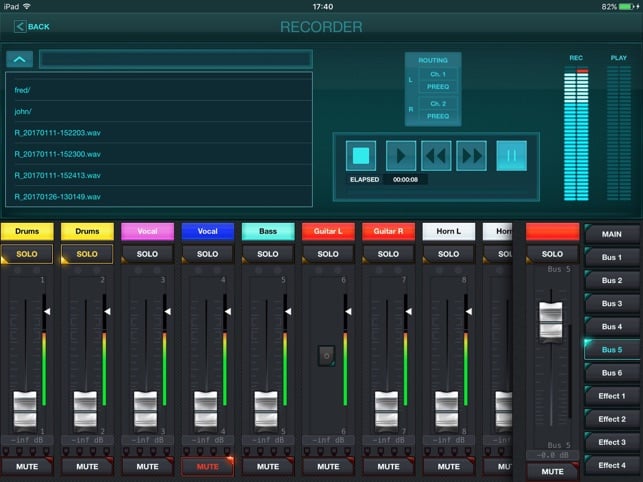
The only downside to both of these mixers is than you can only connect 4 devices simultaneously through Wi-Fi, which on other mixers, like the Soundcraft UI12 and UI16, is quite higher.
This should still be enough for most gigging bands, since every- or almost every member of the band will be able to control their own monitor/headphone mix.
Onboard Effects
Both these mixers come with four built-in true-stereo (8 mono) multi-effects processors, including delay, chorus, and dynamics, as well as a 31-band EQ.
You can also choose any combination of high-end simulations of classic studio reverbs such as the Lexicon 480L and PCM70, the EMT250 or Quantec QRS.
Sadly, there is no included feedback rejection/feedback fighting on these mixers, as well as no amp simulation software.
Features
- Built-in award-winning MIDAS preamps
- Fully gain-programmable, remote-controllable preamps
- Light and portable
- Good effects processors and reverb algorithms
Specifications
| Model | Behringer XR12 | Behringer XR16 |
| Channels | 12 | 16 |
| Inputs | 4 x XLR/TRS, 6 x ¼” line, 2 x ¼” Hi-Z | 8 x XLR/TRS, 6 x ¼” line, 2 x ¼” Hi-Z |
| Outputs | 2 x XLR, 2 XLR AUX | 2 x XLR, 4 XLR AUX |
| MIDI I/O | Yes | Yes |
| Headphone Output | 1 x ¼” | 1 x ¼” |
| EQ Bands | 100-band Real Time Analyzer | 100-band Real Time Analyzer |
| Rackmountable | Yes | Yes |
| Multi-track Recording | No | No |
| USB Rec/Playback | Yes | Yes |
| App Required | X-Air App | X-Air App |
| Feedback Control | No | No |
Both of these mixers are affordable and will allow you to mix live shows without the need of running cables all over the place.
Find our more about the Behringer XR12 and XR16 here:
- Behringer XR12: Amazon, Sweetwater.
- Behringer XR16: Amazon, Sweetwater.
Differences
Both the Soundcraft UI12 and UI16 provide amp simulation and feedback rejection, which the Behringer XR12 and XR16 don’t.
However, the Behringer mixers do provide MIDI In/Out, which the Soundcraft Mixers don’t.
Other than that, there are no important differences that could make you decide between one or the other.
Which one to choose?
I would personally go with the Soundcraft mixers for the simple fact that they provide some excellent amp simulation which obviously means that your band won’t need to take their guitar/bass amps with them.
Additionally, the feedback suppression software can really come in handy.
The only reason to choose the Behringer XR series over the Soundcraft UI mixers is if you absolutely need the MIDI ins and outs.
Other than that, I think that the Souncraft mixers are overall a bit better, especially for live performances.
Like I mentioned earlier, if you also want wireless mixers which are capable of doing some awesome multi-track recordings, then check this article I wrote about the Behringer XR18 and the Soundcraft UI24R.
Conclusion
All of these mixers are great.
Their build quality is good, they are super versatile since you can set them up on stage, right beside the band, and then control them from anywhere you’d like.
I hope this information was useful!
Have a great day!
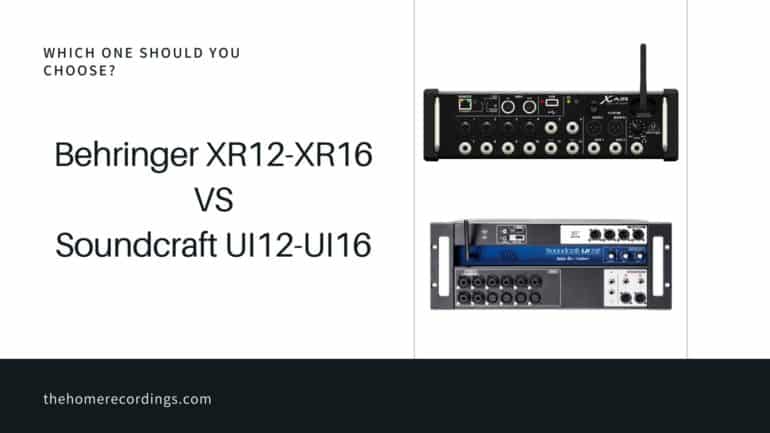
Thxs for this … I Will buy i12
Thank you for your reviews on these units – I’m impressed with the SC Ui12